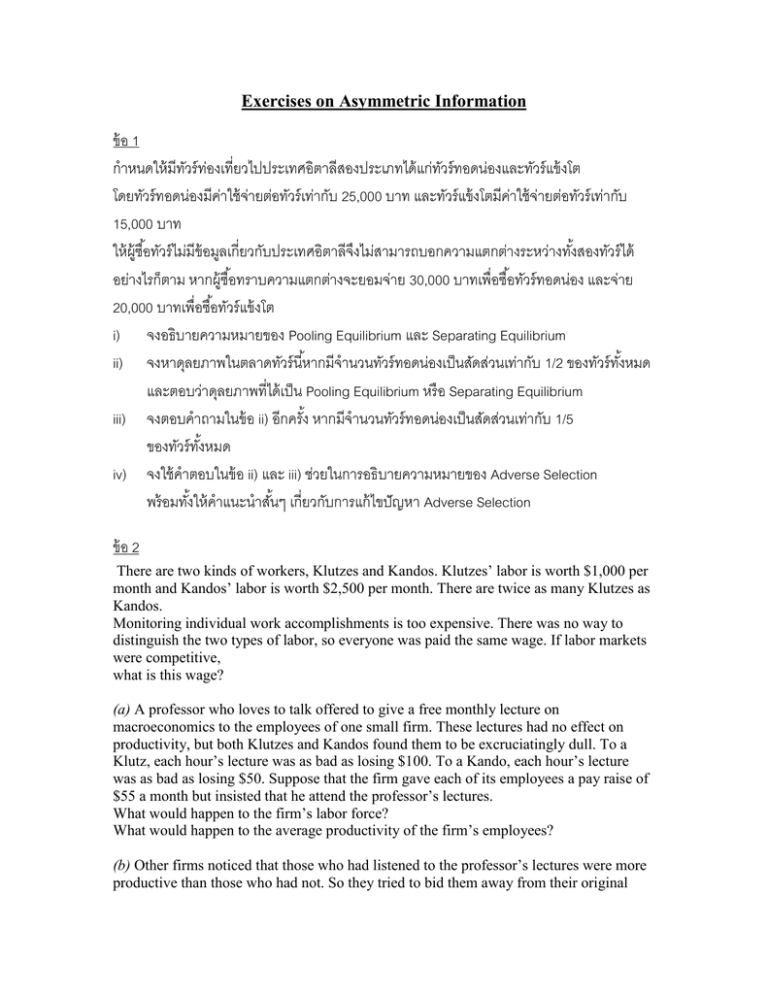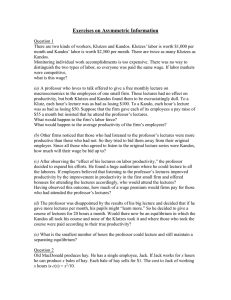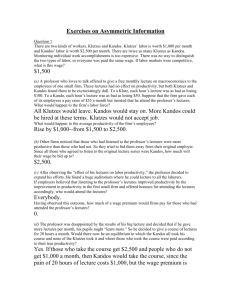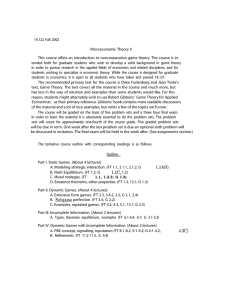ข้อ 1 ก ำหนดให้มีทัวร์ท่องเที่ยวไปประเทศอิตำลีสองประเภทได้แก่ทัวร์ทอดน่องและทัวร์แข้งโต โดยทัวร์ทอดน่องมีค่ำใช้จ่ำยต่อทัวร์เท่ำกับ 25,000 บำท และทัวร์แข้งโตมีค่ำใช้จ่ำยต่อทัวร์เท่ำกับ
advertisement

Exercises on Asymmetric Information ข้ อ 1 กำหนดให้ มีทวั ร์ ทอ่ งเที่ยวไปประเทศอิตำลีสองประเภทได้ แก่ทวั ร์ ทอดน่องและทัวร์ แข้ งโต โดยทัวร์ ทอดน่องมีคำ่ ใช้ จำ่ ยต่อทัวร์ เท่ำกับ 25,000 บำท และทัวร์ แข้ งโตมีคำ่ ใช้ จ่ำยต่อทัวร์ เท่ำกับ 15,000 บำท ให้ ผ้ ซู ื ้อทัวร์ ไม่มีข้อมูลเกี่ยวกับประเทศอิตำลีจงึ ไม่สำมำรถบอกควำมแตกต่ำงระหว่ำงทังสองทั ้ วร์ ได้ อย่ำงไรก็ตำม หำกผู้ซื ้อทรำบควำมแตกต่ำงจะยอมจ่ำย 30,000 บำทเพื่อซื ้อทัวร์ ทอดน่อง และจ่ำย 20,000 บำทเพื่อซื ้อทัวร์ แข้ งโต i) จงอธิบำยควำมหมำยของ Pooling Equilibrium และ Separating Equilibrium ii) จงหำดุลยภำพในตลำดทัวร์ นี ้หำกมีจำนวนทัวร์ ทอดน่องเป็ นสัดส่วนเท่ำกับ 1/2 ของทัวร์ ทงหมด ั้ และตอบว่ำดุลยภำพที่ได้ เป็ น Pooling Equilibrium หรื อ Separating Equilibrium iii) จงตอบคำถำมในข้ อ ii) อีกครัง้ หำกมีจำนวนทัวร์ ทอดน่องเป็ นสัดส่วนเท่ำกับ 1/5 ของทัวร์ ทงหมด ั้ iv) จงใช้ คำตอบในข้ อ ii) และ iii) ช่วยในกำรอธิบำยควำมหมำยของ Adverse Selection พร้ อมทังให้ ้ คำแนะนำสันๆ ้ เกี่ยวกับกำรแก้ ไขปัญหำ Adverse Selection ข้ อ 2 There are two kinds of workers, Klutzes and Kandos. Klutzes’ labor is worth $1,000 per month and Kandos’ labor is worth $2,500 per month. There are twice as many Klutzes as Kandos. Monitoring individual work accomplishments is too expensive. There was no way to distinguish the two types of labor, so everyone was paid the same wage. If labor markets were competitive, what is this wage? (a) A professor who loves to talk offered to give a free monthly lecture on macroeconomics to the employees of one small firm. These lectures had no effect on productivity, but both Klutzes and Kandos found them to be excruciatingly dull. To a Klutz, each hour’s lecture was as bad as losing $100. To a Kando, each hour’s lecture was as bad as losing $50. Suppose that the firm gave each of its employees a pay raise of $55 a month but insisted that he attend the professor’s lectures. What would happen to the firm’s labor force? What would happen to the average productivity of the firm’s employees? (b) Other firms noticed that those who had listened to the professor’s lectures were more productive than those who had not. So they tried to bid them away from their original employer. Since all those who agreed to listen to the original lecture series were Kandos, how much will their wage be bid up to? (c) After observing the “effect of his lectures on labor productivity,” the professor decided to expand his efforts. He found a huge auditorium where he could lecture to all the laborers. If employers believed that listening to the professor’s lectures improved productivity by the improvement in productivity in the first small firm and offered bonuses for attending the lectures accordingly, who would attend the lectures? Having observed this outcome, how much of a wage premium would firms pay for those who had attended the professor’s lectures? (d) The professor was disappointed by the results of his big lecture and decided that if he gave more lectures per month, his pupils might “learn more.” So he decided to give a course of lectures for 20 hours a month. Would there now be an equilibrium in which the Kandos all took his course and none of the Klutzes took it and where those who took the course were paid according to their true productivity? (e) What is the smallest number of hours the professor could lecture and still maintain a separating equilibrium? ข้ อ 3 Old MacDonald produces hay. He has a single employee, Jack. If Jack works for x hours he can produce x bales of hay. Each bale of hay sells for $1. The cost to Jack of working x hours is c(x) = x2/10. (a) What is the efficient number of bales of hay for Jack to cut? (b) If the most that Jack could earn elsewhere is zero, how much would MacDonald have to pay him to get him to work the efficient amount? (c) What is MacDonald’s net profit? (d) Suppose that Jack would receive $1 for passing out leaflets, an activity that involves no effort whatsoever. How much would he have to receive from MacDonald for producing the efficient number of bales of hay? (e) Suppose now that the opportunity for passing out leaflets is no longer available, but that MacDonald decides to rent his hayfield out to Jack for a flat fee. How much would he rent it for? ข้ อ 4 In Pot Hole, Georgia, 1,000 people want to sell their used cars. These cars vary in quality. Original owners know exactly what their cars are worth. All used cars look the same to potential buyers until they have bought them; then they find out the truth. For any number X between 0 and 2,000, the number of cars of quality lower than X is X/2. If a car is of quality X, its original owner will be willing to sell it for any price greater than X. If a buyer knew that a car was of quality X, she would be willing to pay X +500 for it. When buyers are not sure of the quality of a car, they are willing to pay its expected value, given their knowledge of the distribution of qualities on the market. (a) Suppose that everybody knows that all the used cars in Pot Hole are for sale. What would used cars sell for? Would every used car owner be willing to sell at this price? Which used cars would appear on the market? (b) Let X* be some number between 0 and 2,000 and suppose that all cars of quality lower than X* are sold, but original owners keep all cars of quality higher than X*. What would buyers be willing to pay for a used car? At this price, which used cars would be for sale? (c) Write an equation for the equilibrium value of X*, at which the price that buyers are willing to pay is exactly enough to induce all cars of quality less than X* into the market. Solve this equation for the equilibrium value of X*.




